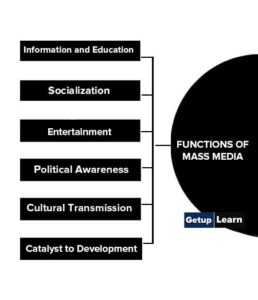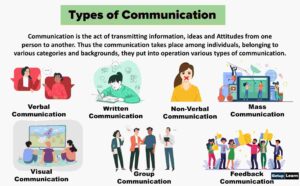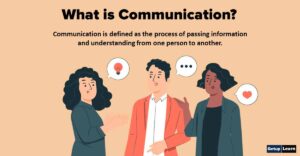Table of Contents
- 1 What are the Barriers of Communication?
- 2 7 Types of Barriers of Communication
- 3 Semantic and Language Barriers of Communication
- 4 Organizational Barriers of Communication
- 5 Physical Barriers of Communication
- 6 Personal Barriers of Communication
- 7 Different Comprehensions of Reality
- 8 Psychological Barriers of Communication
- 9 Other Barriers of Communication
- 10 FAQ Related to Types of Barriers of Communication
What are the Barriers of Communication?
The process of communication is a complex one. When a message is sent by a sender to the receiver, it may be possible that it is not effectively understood by the receiver in the same sense as the sender intended to. There may be several causes for its ineffectiveness. These are called Barriers of communication.
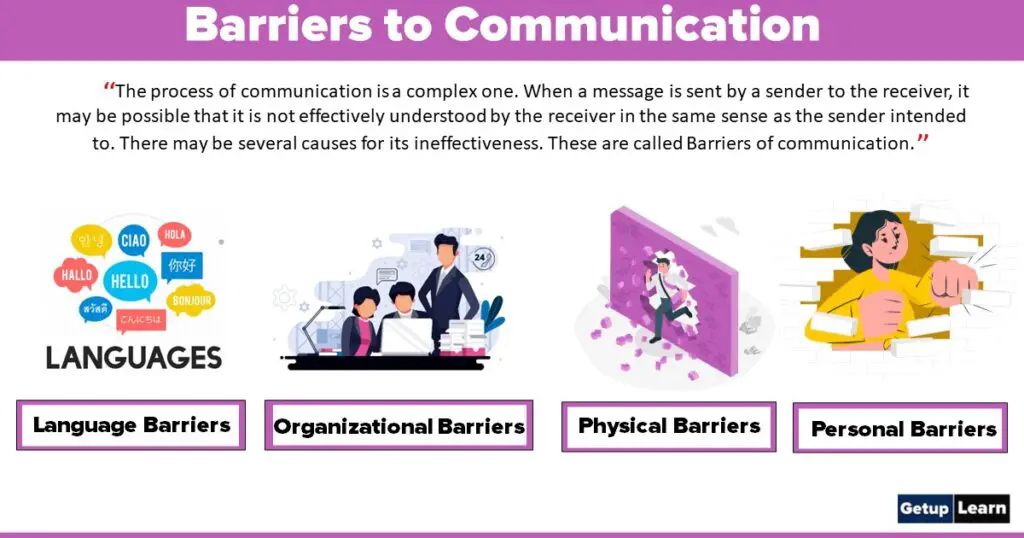
These include problems in encoding and decoding, wrong or defective communication channels, noise in the channel, or several personal reasons. Barriers of communication are obstacles to an effective conversation or good interpersonal interaction. They are high-risk responses having an impact on communication is frequently negative. Below that we will understand the Types of Barriers of Communication in deep.
7 Types of Barriers of Communication
Barriers may arise at any point in the process of communication from the sender or the receiver, in the message, the medium, or the feedback. A barrier can even arise outside the process and still cause an interruption. This means that there are different types of barriers of communication. Types of barriers of communication can be divided into four main groups:
- Semantic and Language Barriers of Communication
- Organizational Barriers of Communication
- Physical Barriers of Communication
- Personal Barriers of Communication
- Different Comprehensions of Reality
- Psychological Barriers of Communication
- Other Barriers of Communication
Semantic and Language Barriers of Communication
There is always a possibility of misunderstanding the feelings of the sender of the message or getting the wrong meaning to it. The receiver in the light of his experience explains the words, signs, and figures used in the communication, which creates doubtful situations. This happens because the information is not sent in simple language. These are the semantic and language barriers of communication:
- Lack of Common Language
- Faulty Translation
- Semantic Barriers
- Unclarified Assumption
- Poor Vocabulary
- Poor Knowledge of Grammar and Punctuation
- Roundabout Verbiage

Lack of Common Language
The language uses oral or written arbitrary symbols to transmit meanings from one person to another. Every human language has its own vocal symbol system and its own grammatical structures. If the communicator and the receiver belong to different language groups, their ignorance of each other’s language or the lack of a common language will be a barrier to communication between them.
It is not possible for them to communicate with each other unless they know some common language that is properly understood by both of them. An English-speaking boss and a Tamil-speaking worker will not be able to communicate without a good knowledge of each other’s language.
If both of them know a common language, say Hindi, their knowledge of Hindi words, inflections, phrases, clauses, and sentence structure should be up to mark to express their thoughts and feelings.
Faulty Translation
A manager receives much information from his superiors and subordinates and he translates it for all the employees according to their level of understanding. Hence, the information has to be molded according to the understanding or environment of the receiver. If there is a little carelessness in this process, the faulty translation can be a barrier to communication.
Semantic Barriers
Most of the communication is carried on through words, whether spoken or written. Words are said to have no meaning but they represent arbitrary meaning associated with them. A word may have a variety of meanings and the meaning attributed to a word by the communicator may not be the same as that of the receiver’s attributed meaning of that word.
A word can have different meanings to different people on different occasions. It is found by the experts that people attribute thousand of different meanings to a few hundred commonly used English words. Therefore, the sender and receiver are many a time likely to attribute different meanings to the same word. Sometimes, they may use different words to communicate the same meaning.
There are many words in English such as light, cheap, etc. which can be used with favorable as well as unfavorable connotations. A word can stand for its positive or negative connotations. Sometimes, the intended meaning of the sender’s word is wrongly entered by the receiver by attributing negative meaning to it.
Unclarified Assumption
It has been observed that sometimes a sender takes it for granted that the receiver knows some basic things and, therefore, it is enough to tell him about the major subject matter. This point of view of the sender is correct to some extent with reference to daily communication, but it is absolutely wrong in the case of some special message.
Special messages should be made absolutely clear; otherwise, there is a possibility of some wrong action in the absence of clarification.
Poor Vocabulary
Poor vocabulary makes our message more complicated. Our pen falters and our tongue fumbles when we probe into our brain for a suitable word or phrase. The words have different connotative and denotative meanings. The communicator needs to know them clearly in order to use them with clarity and precision.
Words stand not only for their meanings but they are also charged with action and emotions when the communicator and the receiver understand these word associations, they are capable of using them as living entities.
Poor vocabulary does not allow the communicator to write or speak effectively. It does not allow the receiver to understand the message clearly and completely if the receiver does riot understand the words, the sentences cannot be properly comprehended by him.
Poor Knowledge of Grammar and Punctuation
Poor knowledge of grammar and punctuation is a barrier to verbal communication. A good vocabulary is of no use unless the communicator acquires the knowledge of how to use it in a sentence. More than ever before, job applicants, business report writers, business correspondents, and all those who are involved in written and oral communications today must have superior grammar skills because an understanding of grammatical structures provides an excellent basis for effective writing, speaking, listening and reading skills.
If the communicator is not able to choose the correct verb form that agrees with a given noun or pronoun; if, he is not able to use nouns and pronouns precisely to indicate who does what; if he is not able to select an exact adjective or adverb; if he is not able to use conjunctions and prepositions to join words correctly, he will not be able to communicate his ideas, thoughts, and feelings fully and correctly.
In addition to good grammar, knowledge of punctuation is essential, for effective communication. Many of us do not pay adequate attention to it. But it must be remembered that faulty and improper punctuation can change the intended meaning of the sentences.
Roundabout Verbiage
Roundabout verbiage consists of the usage of overworked, troublesome, and exhausted words and phrases which usually cause a considerable amount of misunderstanding and confusion. It is a long-winded way of saying meaningless padding. By avoiding such roundabout verbiage, we can add a good deal of liveliness and simplicity of expression to our written as well as oral communication.
For example, instead of saying ‘in the majority of cases’ or ‘in a number of instances, we can say ‘some’ or ‘usually’; instead of saying ‘commence’, we can use ‘start’ or ‘begin’; instead of saying ‘prior to’, we can say ‘before’. Roundabout verbiage should be avoided to achieve clarity and simplicity of the message.
Organizational Barriers of Communication
As far as communication is concerned organizational structure greatly affects the capability of the employees. These are some major organizational barriers of communication:
- Organizational Policies
- Organizational Rules
- Status Relationship
- Complexity in Organizational Structure
- Organizational Facilities
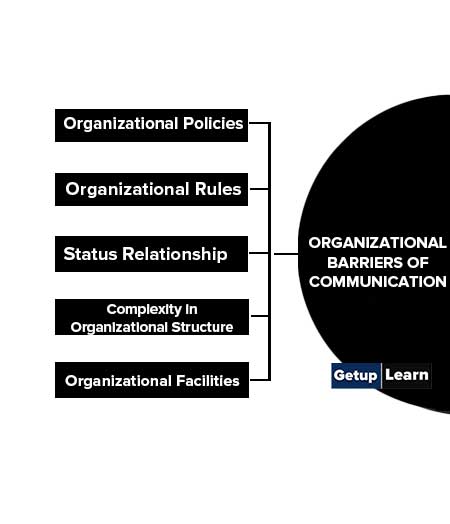
Organizational Policies
Organizational policies determine the relationship among all the persons working in the enterprise. For example, it can be the policy of the organization that communication will be in written form. In such a situation anything that could be conveyed in a few words shall have to be communicated in written form. Consequently, things get delayed.
Organizational Rules
These become barriers in communication by determining the subject matter, medium, etc., of communication. Troubled by the definite rules the senders do not send some of the messages.
Status Relationship
In organizations, all the employees are divided into many categories on the basis of their level. The formal division acts as a barrier in communication especially when the communication moves from the bottom to the top.
For example, when a lower-level employee has to send his message to his superior at the top level there is a lurking fear in his mind that the communication may not be faulty, and because of this fear, he cannot convey himself clearly and in time. It delays the taking of decisions.
Complexity in Organizational Structure
The greater number of managerial levels in an organization makes it more complex. It results in delays in communication and information gets changed before it reaches the receiver. In other words, negative things or criticism are concealed. Thus, the more the number of managerial levels in the organization, the more ineffective the communication becomes.
Organizational Facilities
It means making available sufficient stationery, telephone, translator, etc. where these facilities are sufficient in an organization, the communication will be timely, clear, and in accordance with necessity. In the absence of these facilities, communication becomes meaningless.
Physical Barriers of Communication
Barriers may arise due to specific situations i.e. physical conditions like noise or insignificant light or information overload etc. The following are the physical barriers of communication:

Noise
Noise is quite often a barrier to communication. It interferes with the transmission of the signals. It also refers to the ‘unwanted’ signals of messages which interfere with and disturb the reception of the wanted signals. This disturbance is usually in the form of sounds, but it need not be always the sounds. It can be in visual, audiovisual, written, physical, or psychological forms also.
There are many people who communicate with little signal and much noise. In fact, they communicate extraneous matters which may diminish the interest of the receivers or may even annoy them. In manufacturing organizations, oral communication is rendered difficult by electronic noise like blaring noise of the stereo and such other noises often interfere with communication.
Visual noise can be experienced when a committee member arrives late at the meeting hall and all the committee members are distracted by his arrival. Poor telephone connections which interrupt conversations, smudged-type- scripts, and bad handwriting are some examples of technical noise.
Time
Time also acts as a barrier to the smooth flow of communication. If the employee does not communicate with his superiors for a long time, or if the husband and wife stay away from each other for a long time, it may create a communication gap between them which may affect their relationship.
Time can act as a barrier to communication in some ways also. A guest who arrives at midnight will not be able to communicate well with the host who might feel embarrassed or disturbed in his sleep. Time will now allow two communicators to talk with each other if they work different shifts.
A phone call at midnight can irritate or embarrass the receiver. A husband who keeps his wife waiting for a long time will not find it easy to communicate with her.
Distance
Sometimes the distance between the transmitter and the receiver becomes a mighty barrier. It can happen if the technical devices of communication such as telephone, telex, etc., are not available to link them. Faulty sitting arrangements in the office can create a kind of communication gap that can be eliminated by adjusting the distance.
Distance between the workbenches in the offices or in the modem production departments and half partitions between them is the distance barriers which severely limit the communication among the employees.
Age and Educational Background
The age, maturity, educational background, and the eras in which a person grows up make a generation that inevitably comes in the way of human communication. The generation gap becomes obvious in their use of vocabulary and style of speeches and the values of life to which they adhere.
Considering his age and maturity, we tend to apply different standards of judgment to judge the statements of the speaker. In an organization, older workers gradually form their social groups, which often remain apart from the younger workers. Their likings and interests are different and they take less interest in sports, cocktail parties, and movies.
Sex
When men and women work together in a group, men tend to be more assertive, acquisitive, self-confident, and aggressive than women. Sex stands as a barrier to a direct, honest, and appropriate expression of a female’s thoughts, opinions, and beliefs. On the other hand, man is more assertive in his thoughts and opinions.
It is also found that women are more likely than men to express their emotions and feelings about a situation. But, it must be noticed that these are general tendencies of sex-typed communication behavior and not the rules. The girls tend to be less aggressive because they receive negative results such as rejection, and criticism for such behavior.
They are brought up with the feeling that assertiveness is unfeminine. A girl who is brought up with such feminine conceptions about herself may try to avoid frank eye contact with the interviewer and may even speak in a voice that is almost inaudible.
Personal Barriers of Communication
The barriers, that are directly connected with the sender and the receiver, are called personal barriers. They are divided into two parts:
Following are the barriers related to superiors:
- Attitude of Superiors
- Fear of Position
- Lack of Confidence in Subordinates
- Shortage of Time
- Lack of Attention
Attitude of Superiors
The attitude of the superiors means the importance they give to communication. It means whether the superiors want to send their ideas to others or not. The attitude of the executives or superiors directly affects the flow of communication.
Fear of Position
Everybody desires to have a higher position in their organization. In this hope, they always try to conceal their weaknesses by not communicating their ideas. There is always the fear of position in their mind, that in case the reality comes to light they may have to move to a lower level.
Lack of Confidence in Subordinates
The superiors always think that the lower-level employees are less capable, and therefore, they ignore the information or suggestions sent by them. In order to increase their own importance, the superiors ignore the communication from their subordinates. Consequently, the self-confidence of the employees is lowered.
Shortage of Time
The executives are overburdened with excessive work, so it is not possible for them to organize the information. Thus due to a shortage of time, they do not pay much attention to communication.
Lack of Attention
In some circumstances, the superiors do not pay attention to the importance and utility of communication. As a result of this, the flow of communication gets impeded. Consequently, the work performance gets affected and due to delays in activities, the enterprise has to face many inconveniences.
These are the barriers related to subordinates:
Unwillingness to Communicate
Sometimes the subordinates do not want to send any information to their superiors. They prefer to conceal the information if they feel that the information can have a negative effect on their position.
If it is necessary to send the information they always prefer to send it in modified or amended form so as to make it acceptable to the superior. Thus, by not clarifying the facts, the subordinates become a hindrance to communication.
Lack of Proper Incentive
Lack of incentive to the subordinates creates a hindrance in communication. It is because of the fact that their suggestions or ideas are not given any importance. If on any occasion the superiors ignore the subordinates, they prefer not to exchange any information in the future.
Different Comprehensions of Reality
Reality is not a fixed concept, it is complex, finite, and continually changing. Every individual has limited sensory perception and a unique mental filter. The reality of an object, an event, or a person is not identical to two persons. On the basis of different evaluations, individuals comprehend reality in different ways. This leads to miscommunication. The point of different comprehensions are:

Abstracting
Abstracting is a process of focussing attention on some details and omitting others. It helps in saving time, space, and money. But sometimes we believe that whatever we know or say about an object or event is worth knowing or saying about it and the less we know, the more sure we feel that we know it all.
We can overcome these barriers if we make our abstract as fairly representative of the whole situation as possible. We should realize that others can pick different ideas and facts from the same situations and we should be mentally prepared to consider what they have to say about it.
Slanting
Slanting means giving a particular slant to reality. We are aware of different aspects but we deliberately select a few and make them representative of the whole. If an individual is accustomed to reality, we consider him a drunkard and tend to forget that he is our good friend and a kind-hearted man.
This happens because we are not objective in our observations and assessments. To avoid this we should not make judgments on the basis of a fraction of facts.
Inferring
Inferring means drawing inferences from the observations. Whatever an individual feel, taste, hear, see, smell or immediately verify, constitute fact? And our statements and conclusions beyond these facts are called inferences. These inferences should be reliable and based upon verifiable facts.
The experts of one field i.e. marketing, advertisers, architects, engineers, designers, etc. always draw verifiable observations about their field, but a non-expert always draws inferences without verifiable facts, thus, wrong inferences can surely be a barrier of communication. Thus to avoid this barrier, the inferences should be based upon verifiable facts.
Psychological Barriers of Communication
The importance of communication depends on the mental condition of both parties. A mentally disturbed party can be a hindrance to communication. Following are the psychological barriers in the way of communication:
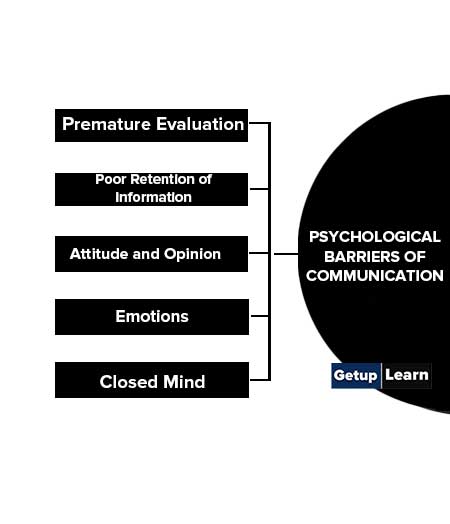
Premature Evaluation
Sometimes the receiver of information tries to dig out the meaning without much thinking at the time of receiving or even before receiving information, which can be wrong. This type of evaluation is a hindrance in the exchange of information and the enthusiasm of the sender gets dampened.
Poor Retention of Information
Poor Retention of Information means that with every transfer of information its reality gets reduced. According to some researchers, in oral communication, there is a loss of 30 percent in every transfer of information. This happens due to the carelessness of human nature and limited memory.
Attitude and Opinion
Individual attitudes and opinions often act as a barrier to communication. If information is in consonance with our opinion we tend to accept it favorably otherwise we do not favorably react to that. If the new policy is in the employee’s favor, they welcome it, otherwise, they reject it. Similarly, different people have different attitudes and opinions and as such their interpretations of the same thing will be dissimilar.
Emotions
Some people are emotional by nature and loss their mental balance quickly and easily. If a superior happens to get agitated quickly, his communication, howsoever, argumentative, is likely to be rejected. Similarly, if the receiver of the message is mentally upset or disturbed he will find unfavorable meaning to it.
Thus, a person in different emotional states is more likely to give different meanings to the same cues or information.
Closed Mind
If the listener has a closed mind, he will always evaluate things from his own point of view and will not be receptive to new ideas. Such a person is not open to conviction and persuasion. Thus it is very difficult to communicate with him. Therefore, it is rightly said that we see what we want to see and hear what we want to hear.
Other Barriers of Communication
Other barriers of communication are explained below:

Source
The source from where the message emanates is very important. People with predetermined and preoccupied attitudes are prejudiced towards some persons who they wish to contact. If these (senders) are the sources of the message, they may behave in a hostile manner towards the other people (receiver).
The receiver may read into the message something more or something less, than what is apparent. Hence the source of communication is important in an organization to pass on essential and required communication.
Cultural Barriers
Cultural differences often cause communication problems. The same category of words, phrases, symbols, actions, and colors mean different things to people of different countries/cultural backgrounds.
For example, in Western countries black color is associated with death and mourning while in the far East white is the color of mourning. In the United States, people love to be called by their first name while in Britain people are more formal and like to be addressed by their title or last name.
Distortion
If the messages are not received properly or they are not properly translated, due to several distractions of the speaker, say his behavior, makes the receiver not receive the message fully, thus, causing barriers of communication.
Read More Related Articles
[su_spoiler title=”What is Communication? | Mass Communication” style=”fancy” icon=”plus-circle”]
What is Communication?
[/su_spoiler]
[su_spoiler title=”Types of Communication | Principles of Communication” style=”fancy” icon=”plus-circle”]
-
Types of Communication
- Verbal Communication
- Non-Verbal Communication
- Written Communication
- Visual Communication
- Feedback Communication
- Mass Communication
- Group Communication
[/su_spoiler]
[su_spoiler title=”Nonverbal Communication | Verbal Communication” style=”fancy” icon=”plus-circle”]
[/su_spoiler]
[su_spoiler title=”Written Communication | Oral Communication” style=”fancy” icon=”plus-circle”]
Written Communication
[/su_spoiler]
[su_spoiler title=”Business Communication | Organizational Communication” style=”fancy” icon=”plus-circle”]
[/su_spoiler]
[su_spoiler title=”Formal Communication | Informal Communication” style=”fancy” icon=”plus-circle”]
[/su_spoiler]
[su_spoiler title=”Interpersonal Communication | Informal Communication” style=”fancy” icon=”plus-circle”]
[/su_spoiler]
[su_spoiler title=”Downward Communication | Upward Communication” style=”fancy” icon=”plus-circle”]
[/su_spoiler]
[su_spoiler title=”Barriers to Communication | Horizontal or Lateral Communication” style=”fancy” icon=”plus-circle”]
[/su_spoiler]
[su_spoiler title=”Self Development | Effective Communication” style=”fancy” icon=”plus-circle”]
[/su_spoiler]
[su_spoiler title=”Difference Between Oral and Written Communication | Theories of Communication” style=”fancy” icon=”plus-circle”]
[/su_spoiler]
What are the 6 barriers to communication?
Following are the 6 types of barriers of communication:
1. Semantic and Language Barriers of Communication
2. Physical Barriers of Communication
3. Personal Barriers of Communication
4. Different Comprehensions of Reality
5. Psychological Barriers of Communication
6. Other Barriers of Communication
What are examples of language barriers?
Following are language barriers of communication:
1. Lack of Common Language
2. Faulty Translation
3. Semantic Barriers
4. Unclarified Assumption
5. Poor Vocabulary
6. Poor Knowledge of Grammar and Punctuation
7. Roundabout Verbiage.
What are the types of Organisational barriers?
Following are the types of Organisational barriers of communication:
1. Organizational Policies
2. Organizational Rules
3. Status Relationship
4. Complexity in Organizational Structure
5. Organizational Facilities.
What are the five physical barriers of communication?
These are the five physical barriers of communication:
1. Noise
2. Time
3. Distance
4. Age and Educational Background
5. Sex.
What are the 5 types of psychological barriers?
Following are the 5 types of psychological barriers of communication:
1. Premature Evaluation
2. Poor Retention of Information
3. Attitude and Opinion
4. Emotions
5. Closed Mind.

